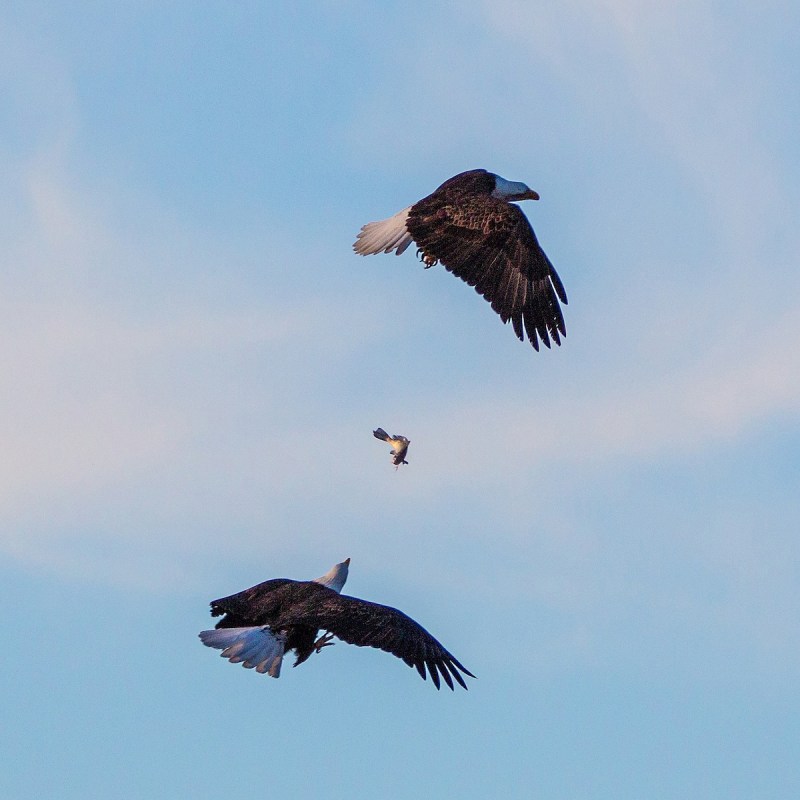
Lecompton, Kansas, was originally named Bald Eagle because so many bald eagles nested there each winter. By the 1950s and 1960s, pesticides harmed many eagles. The species became endangered, and eagles vanished from the state. In 1989, the first bald eagles returned to Kansas, building a nest at Clinton Lake southwest of Lawrence. Now, many places in Kansas have eagles and offer viewing opportunities. Visit Kansas in mid-January to mid-February for the best shot at seeing eagles.
Videos by TravelAwaits
Before we get into the fantastic places to see bald eagles in Kansas, here are some things you need to know:
Early Risers See More Birds
Mornings are the best time for eagle watching. Arrive at your chosen eagle-watching spot from sunrise to about 10 a.m. During the afternoon, the birds are soaring high and good images are difficult to obtain. As daylight comes to a close, search again. The birds will be trying to grab one more meal before darkness falls.
To see eagles, look for large unfrozen bodies of water, including reservoirs where spillways prevent ice formation.
In the winter, the eagles will be hunting. Their diet is mainly fish, but also includes small mammals. They also scavenge for food, including stealing from other birds. They eat carrion and garbage.

Juvenile Bald Eagle Vs. Golden Eagle
The bald eagle does not receive its iconic plumage for 5 years. In a juvenile eagle’s first year, the bird looks much like a golden eagle. During the next few years, the bird plumage mottles and lightens and its eyes turn from dark to golden. Its beak lightens from grayish-black to bright yellow. With the eagle’s size, you might expect its voice to be like James Earl Jones’s. Instead, the bird has a high, weak sounding voice.
The birds perch on tall, mature trees that offer excellent lookout points.
If you cause an adult bird to fly away from its nest, you are too close. Stay at least 100 yards away from the birds.
Bald Eagle Photography Tips
The Audubon Society offers the following photography tips:
- Bald eagles’ white heads and dark bodies make exposure difficult. If using an adjustable camera, set your exposure for midtones. The best light is early morning, but cloudy days also work well.
- When tracking the bird across the sky, set your camera to continuous autofocus. Pay attention to your target bird’s behavior. For example, eagles are thieves. If the eagle is approaching another bird, perhaps to steal food, focus on the targeted bird before the eagle arrives.
- Maintain a 1/125th of a second minimum shutter speed. To catch a flying bird, use 1/3000th of a second. The closer the bird, the faster the speed required.
- Focus on the bird as it approaches you, but wait to start shooting until it starts filling your frame.
Got it? Great. Now pack your camera and let’s visit the following bald eagle viewing sites in Kansas.
Note: Some of the places listed have hosted me, but all opinions are my own.

1. Bald Eagle River View Park, Lecompton
Lecompton is mainly known as the Kansas Territorial Capital, and the best place to view the big birds is at the park behind the 1850s Kansas Democratic Headquarters. The political party no longer uses the Lecompton building, but the birds will make up for any lack of political intrigue. Park at the Democratic Headquarters lot and walk behind the building.
Pro Tip: Explore early Kansas history on Lecompton’s walking trail, and stop for pie at Aunt Netter’s Café, one of the stops on our I-70 foodie road trip.

2. Clinton State Park, Lawrence
Celebrate the eagles’ return to Kansas at Clinton. Gather the most up-to-date information at the Corps of Engineers Information Center, then walk the Backwoods Nature Trail. Drive through the Clinton Wildlife Area. The area includes the reservoir’s Deer Creek Arm, where the 1989 eagles nested.
Pro Tips: Learn more about wildlife, including eagles, at Lawrence’s Prairie Park Nature Center. It’s one of the things to do on our weekend in Lawrence itinerary. For more eagle views, visit Riverfront Park. The waterfall created by Bowersock Dam below the park clears the Kansas River of ice. The eagles watch for fish that are stunned after their plunge over the dam. A steep boat ramp goes down to the river from the park. An interpretive sign by the boat ramp tells about the eagles.
3. Milford State Park, Milford
Eagle Ridge Trail at Milford Lake State Park lives up to its name. The 6.1-mile trail offers numerous opportunities to view the national bird. Watch for eagles soaring above the reservoir and the surrounding countryside.
To learn more, visit Milford Nature Center on its annual Eagle Day. The activities include live eagles, and bus rides to eagle viewing. Enjoy free popcorn and hot chocolate, plus free admission to Milford State Park. Eagle Day 2022 is scheduled for January 22. The nature center includes a large birds of prey exhibit. The exhibit features both a bald eagle and a golden eagle.
Pro Tip: The causeway on Milford Reservoir’s north end is a prime eagle viewing area. Leave your car in Clay County Park, on the causeway’s west end.

4. Tuttle Creek State Park, Manhattan
Bring your spotting scope and long lens to River Pond below Tuttle Creek Lake’s dam. Watch for eagles fishing and resting on Eagle Island. Also look for the birds at the Kansas State University Range Research Unit 2 miles southwest of the dam and beside Prairie Parkway east of the lake.
Pro Tip: Explore great dining in nearby Manhattan.
5. Cheyenne Bottoms Preserve and Wildlife Area, Great Bend
Bald eagles spend the winter at Cheyenne Bottoms. They arrive in November and stay as late as March. Look for nesting pairs on the wildlife preserve’s southern edge. The raptors feed on fish and cull geese flocks. You may see them standing on the ice.
Before touring the bottoms, stop at the Kansas Wetlands Education Center. Book a guided tour or follow the self-guided tour.
Pro Tip: Great Bend is one of our seven incredibly charming Kansas towns.

6. Quivira National Wildlife Refuge, Stafford County
Bald eagles start arriving at Quivira in late October. Look for them in Big Salt Marsh and Little Salt Marsh. Their numbers increase until mid-December, then taper off until March. Some will stay throughout the year, but most will be gone by spring.
Pro Tips: Quivira offers a self-guided tour that includes Little Salt Marsh. An 8-foot tall accessible observation tower at the marsh enables panoramic views. The Migrants Mile Trail’s south end has a photo blind and a connector trail to the visitor center. Download a trail map (PDF). Telescopes are available on the Wildlife Drive. Download directions to the refuge (PDF).

7. Kirwin National Wildlife Refuge, Kirwin
Many of Kirwin’s eagles are juveniles with brown plumage. Their numbers peak during mid-December and then taper until March. Look for nests on the north side of Kirwin Reservoir.
8. Chaplin Nature Center, Arkansas City
Chaplin Nature Center is nestled in a bend of the Arkansas River, where eagles feed near the shallow banks. The center offers a Winter River Hike in January and Bald Eagle Nest Viewing in March. The nest viewing event takes hikers to Arkansas City’s Veterans Memorial Lake.
Pro Tip: In Kansas, the Arkansas River is pronounced arr-KAN-zus, as is Arkansas City. However, most people shorten the city’s name to Ark City.

9. El Dorado State Park, El Dorado
Stands of flooded timber beckon eagles to El Dorado Lake, northeast of El Dorado. In some years, 150-plus raptors call the park home. Look for the eagles in the Walnut River Park area.
Pro Tip: Both Ark City and El Dorado are easy day trips from Wichita.
10. Wyandotte County Lake, Kansas City
Look for bald eagles atop the tallest trees at Wyandotte County Lake in Kansas City (KCK). The bare limbs attract the iconic birds, as do the abundant fish. After you watch the birds, explore the KCK Taco Trail.
Pro Tips: Mr. and Mrs. F.L. Schlagle Public Library stands next to Wyandotte County Lake in Kansas City. The library is one of only two public library environmental learning centers in the United States. Among other services, residents may check out binoculars for better wildlife viewing.

11. Flint Hills National Wildlife Refuge, Hartford
Over 100 bald eagles may winter at Flint Hills National Wildlife Refuge 8 miles south of Kansas Turnpike Exit 141. Watch for eagles at Eagle Point, a rocky outcropping on the Dove Roost Trail.
Pro Tip: Take a break from the eagles and visit nearby Emporia, one of the stops on our Prairie Road Trip.
12. Glen Elder State Park, Glen Elder
The centerpiece of Glen Elder State Park, Waconda Lake is the state’s third-largest reservoir. The trees along the lakeshore welcome eagles each winter. Look for them in the Glen Elder Wildlife Area that surrounds the park.
Pro Tips
If you find an eagle feather, you may photograph it, but you must leave it where you found it. This (PDF) will help determine whether the feather belongs to an eagle. Possessing eagle feathers or body parts is illegal. Tribal members are an exception to this rule. This site offers tips if you find a dead or injured eagle.
When you register your vehicle in Kansas, buy a state parks passport for only $15.50. It’s valid for the life of your registration. Otherwise, annual passes cost $25 and are $5 daily. State park camping fees are extra.
For more on winter travel, check out:
